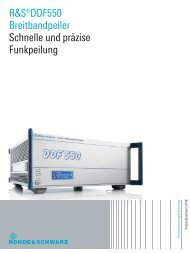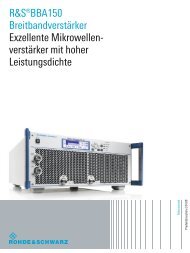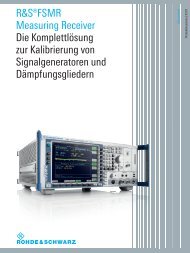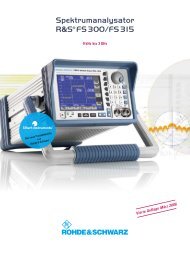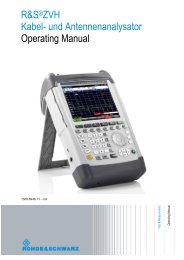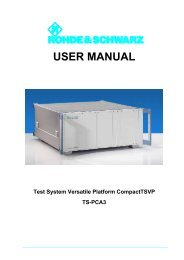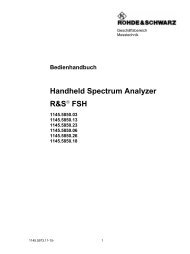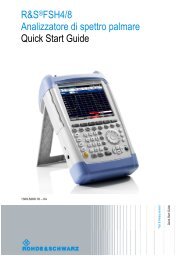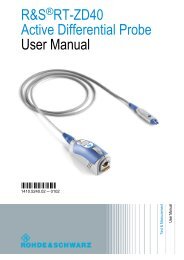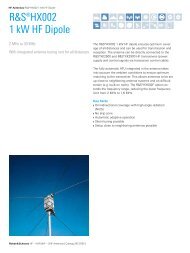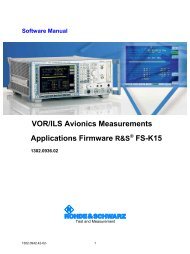R&S ZNB Guide de demarrage rapide - Rohde & Schwarz Singapore
R&S ZNB Guide de demarrage rapide - Rohde & Schwarz Singapore
R&S ZNB Guide de demarrage rapide - Rohde & Schwarz Singapore
You also want an ePaper? Increase the reach of your titles
YUMPU automatically turns print PDFs into web optimized ePapers that Google loves.
R&S ® <strong>ZNB</strong><br />
Matériaux d'emballage<br />
<strong>Gui<strong>de</strong></strong> <strong>de</strong> démarrage rapi<strong>de</strong> 1316.0062.09 ─ 05<br />
Mise en service <strong>de</strong> l'analyseur<br />
Retain the original packing material. If the instrument needs to be transported or shipped<br />
at a later date, you can use the material to protect the control elements and connectors.<br />
Risk of instrument damage during transportation and shipment<br />
Insufficient protection against mechanical and electrostatic effects during transportation<br />
and shipment can damage the instrument.<br />
● Always make sure that sufficient mechanical and electrostatic protection is provi<strong>de</strong>d.<br />
● When shipping an instrument, the original packaging should be used. If this is not<br />
available, allow for sufficient padding to prevent the instrument from moving around<br />
insi<strong>de</strong> the box. Pack the instrument in antistatic wrap to protect it from electrostatic<br />
charging.<br />
● Secure the instrument to prevent any movement and other mechanical effects during<br />
transportation.<br />
The carrying handles at the front are <strong>de</strong>signed to lift or carry the instrument. Do not<br />
apply an excessive external force to the handles.<br />
2.2 Positionner l'appareil<br />
L'analyseur <strong>de</strong> réseaux est conçu pour être utilisé dans <strong>de</strong>s conditions <strong>de</strong> laboratoire,<br />
soit sur un banc d'essai, soit dans un bâti. Tenir compte <strong>de</strong>s conditions <strong>de</strong> fonctionnement<br />
générales au lieu <strong>de</strong> fonctionnement telles qu'elles sont décrites à la section "Risk of<br />
instrument damage during operation" à la page 8.<br />
Risque <strong>de</strong> décharge électrostatique<br />
Positionner l'appareil<br />
La décharge électrostatique (DES) est susceptible <strong>de</strong> provoquer <strong>de</strong>s dommages aux<br />
composants électriques du dispositif sous mesures et à l'analyseur. La DES peut apparaître<br />
plus probablement lorsque vous connectez ou déconnectez un dispositif sous<br />
mesure ou un appareil d'essai fixe aux ports <strong>de</strong> test <strong>de</strong> l'analyseur.<br />
Pour prévenir la DES, utiliser un bracelet et une cor<strong>de</strong> antistatiques et se connecter au<br />
connecteur <strong>de</strong> mise à la terre disposé au panneau arrière du R&S <strong>ZNB</strong>. Pour plus d'informations,<br />
se référer aux "Instructions pour la protection contre la décharge électrostatique"<br />
fournies sur le CD-ROM <strong>de</strong> documentation du R&S <strong>ZNB</strong>.<br />
9



